What’s new history
This article provides information about new features included in the releases that shipped after the 1912 Long Term Service Releases (LTSR) through the 2411 Current Releases (CR).
What’s new in 2503
This release includes the following new features and addresses issues to improve the user experience:
Session recording for Citrix-delivered web apps (Preview)
Session Recording extends its capabilities beyond recording activities within virtual app and desktop sessions (VDI) to also capture user actions on endpoint devices accessing Citrix-delivered web apps. For more information, see Session Recording for Endpoint Devices.
Alternative message queuing solution
Session Recording offers the Session Recording message queue as an alternative to the default Microsoft Message Queue (MSMQ). You can switch between them through registry settings. For more information, see Choose the message queuing solution.
Enhanced print monitoring
Session Recording provides more detailed information about printed content during recorded sessions. You can also choose to save a copy of the printed files along with the recordings. To enable this feature, configure an event detection policy and select printing events to log. For more information, see Configure event detection policies.
Key improvements:
-
More detailed print logs: Capture more data about printed content, including file name, file size, author, printer name, timestamp, and more.
-
Saved print files: Optionally store copies of printed files alongside session recordings for future reference and auditing.
-
Enhanced replay insights: View detailed print information and access printed files directly within the session replay interface. For more information, see Printing activities.
This enhancement allows for greater oversight and auditing of printing activity within recorded sessions.
Idle event enhancements
In Session Recording 2503, the idle event feature is now enabled by default. This means Session Recording can automatically record periods of inactivity (idle periods). Previously, this feature required an active event detection policy. This release also introduces finer-grained control over response actions, which can now be triggered based on idle durations measured in minutes rather than hours. You can disable the idle event feature by setting the EnableIdleEvent registry key to 0.

For more information, see Highlight idle periods and Configure event response policies.
Enhanced Session Recording agent management
This release introduces significant improvements to Session Recording agent management. Previously, only VDAs with Session Recording agents installed and sessions or events recorded were tracked. Now, all VDAs are monitored. You can use the SsRecUtils.exe utility to:
-
Check the counts of VDAs with and without Session Recording agents installed.
-
View the connection status of all Session Recording agents.
These enhancements provide greater visibility into agent deployments and more control over agent status and health, making it easier to manage and maintain your recording infrastructure. For more information, see Monitor Session Recording agents.
What’s new in 2411
This release includes the following new features and addresses issues to improve the user experience:
Important note about upgrading to version 2411:
To prevent session recording failures due to incomplete upgrades of Session Recording agents, follow these steps when upgrading to 2411:
- Upgrade each Session Recording server to version 2411.
Enable remote access using .NET Remoting with the following command:
<Session Recording server installation path>\Bin\SsRecUtils.exe -EnableBrokerRemoting <!--NeedCopy-->- Upgrade each Session Recording agent to version 2411.
After all Session Recording agents are upgraded, disable remote access using .NET Remoting with the following command:
<Session Recording server installation path>\Bin\SsRecUtils.exe -DisableBrokerRemoting <!--NeedCopy-->
Group Managed Service Account (gMSA) support for Session Recording
Session Recording now supports Group Managed Service Accounts (gMSAs) to simplify service principal name (SPN) management for services running on multiple servers. This feature enhances security and simplifies the management of service accounts. For more information, see the best practice article: Configure Group Managed Service Accounts (gMSAs) support for Session Recording.
Support for Microsoft Entra ID authentication
In addition to SQL Server authentication, Session Recording now supports Entra ID authentication for cloud-based SQL databases including Azure SQL Database and Azure SQL Managed Instance. To enable Entra ID authentication, include the AADPASSWORD parameter and set it to 1 when installing the Session Recording database through the command line. For more information, see Install, upgrade, and uninstall.
Support for installing databases on separate Instances
You can now install the Session Recording database and Session Recording admin logging database on separate instances. To enable this feature, complete the following steps before installing the databases:
- Go to the machine where the Session Recording server is installed.
- Open the Registry Editor.
- Modify the registry:
- Navigate to
HKEY_LOCAL_MACHINE\SOFTWARE\Citrix\SmartAuditor\Server. - Add the
SmAudDatabaseLoggingStateDWORD (32-bit) value and set the value data to1. - Add the
SmAudDatabaseLoggingInstancevalue. Set the value data to the instance name where you want to install the Session Recording admin logging database.
- Navigate to
Later when you install the databases through either a GUI or command line, the admin logging database is installed on the separate instance specified by the SmAudDatabaseLoggingInstance registry value. For more information about Session Recording installation, see Install, upgrade, and uninstall.
Capturing printing activities in recorded sessions is now generally available
You can capture printing activities that occur during recorded sessions and tag them as events in recordings for later search and playback. The feature is now generally available and has been enhanced to capture the full paths of printed files. For more information, see Configure event detection policies.
Enhanced diagnostic logging
More types of diagnostic logs, beyond message queue quota exceedance, can now be detected on the Virtual Delivery Agents (VDAs) and sent to the Session Recording server. Previously, diagnostic logs were visible in the Windows Event Viewer, but they are now visible in the Session Recording web player. For more information, see View diagnostic logging.
What’s new in 2407
This release includes the following new features and addresses issues to improve the user experience:
Hide screen areas for specific applications during Thinwire screen recording
Previously, hiding screen areas for specific applications was only available for lossy screen recording. Starting with release, you can also hide screen areas for specific applications when recording session screens transmitted over Thinwire.
Tip:
Thinwire, a part of Citrix HDX technology, is the Citrix default display remoting technology used in Citrix Virtual Apps and Desktops. Display remoting technology allows graphics generated on one machine to be transmitted, typically across a network, to another machine for display.
For more information, see Create a custom recording policy.
Capture printing activities in recorded sessions (preview)
We have extended the scope of event detection to monitor and tag printing activities during recorded sessions as events for later search and playback.
To use this feature, make sure that:
- You have configured and activated a session recording policy that specifies sessions to record. For more information, see Configure session recording policies.
- You have created an event detection policy and selected the Log printing activities option for it. For more information, see Create a custom event detection policy.
Note:
This feature is a preview feature available with Session Recording version 2407 and later. Preview features might not be fully localized and are recommended for use in non-production environments. Citrix Technical Support doesn’t support issues found with preview features.
Report message queue quota exceedance on each VDA to the Session Recording server
In any of the scenarios outlined below, there’s a chance of exceeding the maximum size of the Microsoft Message Queuing (MSMQ) directory on a VDA. This issue can result in packet drops or pushback.
- On the VDA side, the incoming rate of Message Queuing messages exceeds the outgoing rate.
- The network connection between the VDA and the Session Recording server is poor and thus messages are stuck in the queue on the VDA side.
- The queue quota on the Session Recording server side is used up and messages are stuck in the queue on the VDA side.
To facilitate diagnoses and troubleshooting, Session Recording can now capture and report the issues as logs to the Session Recording server for display in the Windows Event Viewer. This feature is enabled by default. You can disable and re-enable the feature by using the following registry value on the target VDA:
HKEY_LOCAL_MACHINE\SOFTWARE\Citrix\SmartAuditor\Agent\DiagnosticLoggingEnabled
Value data: 1 = enabled, 0 = disabled
You can also set how long these logs can be retained on the Session Recording database. To do so, go to the Logging tab of Session Recording Server Properties and configure the Retention period for diagnostic logs. The default value is 30 days.
For more information, see Diagnostic logging.
Dynamic screen recording through Citrix PowerShell SDKs extended to event-only recording
You can now run PowerShell commands that Citrix SDKs provide to start recording the screen at any time during a session. Previously, this feature was unavailable for sessions that fall into the scope of an event-only recording policy. With this release, you can dynamically turn an event-only recording into a screen recording, capturing the screen along with the target events.
For more information, see Configure session recording policies and Dynamically start or stop recording by using PowerShell commands in the Citrix SDKs.
What’s new in 2402 LTSR (initial release)
This release includes the following new features and addresses issues to improve the user experience:
Session Recording database is now made the mandatory subfeature of the Session Recording server
When the Session Recording server is selected for installation, the Session Recording database is now also selected automatically and cannot be unselected. This enhancement helps avoid installation or upgrade issues in load balancing scenarios. For more information, see Install, upgrade, and uninstall.
Contextual session recording based on smart access tags
When creating a custom policy, you can now specify smart access tags to use as scopes for the policy to apply to. This feature lets you apply policies based on the user access context including:
- The user’s location
- IP address range
- Delivery group
- Device type
- Installed applications
This feature brings more granular control over session recording and is available for the following policies:
- Session recording policies. For more information, see Configure session recording policies.
- Event detection policies. For more information, see Configure event detection policies.
- Event response policies. For more information, see Configure event response policies.
Azure Active Directory (AD) support (preview)
You can now install the Session Recording server and agent on an Azure AD joined machine and enable Azure AD support for them. Later when you configure various policies and playback permissions from the cloud, you can specify Azure AD users and groups who launch sessions from Azure AD joined machines.
For information about installing Session Recording, see Install, upgrade, and uninstall.
For information about configuring policies and playback permissions from the cloud, see Configure session recording policies and Playback permissions.
What’s new in 2311
This release includes the following new features and addresses issues to improve the user experience:
Audio recording for non-optimized HDX™ audio is now generally available
You can enable audio recording for non-optimized HDX audio when configuring session recording policies. The feature is now generally available and enhanced to let you adjust the volume during recording playback.
Note:
The audio that is handled on the VDA and delivered to/from the client where the Citrix Workspace app is installed is referred to as non-optimized HDX audio. Unlike non-optimized HDX audio, optimized HDX audio has its processing offloaded to the client, as seen in the Browser Content Redirection (BCR) and Optimization for Microsoft Teams scenarios.
For information about enabling audio recording, see Configure session recording policies.
Prerecording also available for virtual app sessions
When you specify event-triggered dynamic screen recording, you can configure the amount of time of the screen recording you want to keep before triggering events are detected. This prerecording feature is now extended to virtual app sessions. It is now available for both virtual desktop sessions and virtual app sessions. For more information, see Configure event response policies.
Note:
When you configure lossy screen recording, note the following changes:
- The Medium and High values for the Video fluency (FPS) compression option have changed to 5 and 10, respectively.
- Session Recording now uses Average Bitrate (ABR) instead of Constant Rate Factor (CRF) for video bitrate encoding. Note it when you set the Video image quality compression option.
For more information, see the compression option descriptions in Enable or disable lossy screen recording.
Hide specific applications during screen recording
You can now hide specific applications with a layer mask during screen recording. This feature requires that you enable lossy screen recording in your custom session recording policy.
For more information, see Create a custom recording policy.
Explicit user consent before recording sessions
If the active recording policy records sessions with notifications, users receive recording notifications after typing credentials. This feature forces end users to explicitly consent to the session recording disclaimer before they can continue with their session. If end users accept the disclaimer, their session continues with session recording enabled. If end users deny the disclaimer, their session is terminated.
To enable this feature, go to the Notifications tab of Session Recording Server Properties and select Allow end user to deny recording of their session. For more information, see Customize recording notification messages.
Store recording files in Amazon Simple Storage Service (Amazon S3)
You can now store recording files in Amazon S3. For more information, see Store recordings in Amazon S3.
Ability to play completed and live session recordings on Citrix Director
You can now play completed and live session recordings on Citrix Director. For more information, see the Citrix Director documentation.
Regular event response reports
You can now schedule reports through Session Recording Server Properties to receive emailed event response reports on a daily or weekly basis. An event response report contains a digest chart as the email body and a csv file as the attachment. The csv file includes a full list of the events during the day or week that have triggered various event responses.
Note:
By selecting email notifications as the event response in your custom event response policy, you can still be notified about each individual occurrence. You can choose regular event response reports, individual notifications, or both.
For more information, see Event response reports.
Ability to check the recording success rate
You can check the recording success rate to learn whether all sessions that match the currently active recording policy are recorded. If all sessions that match the currently active recording policy are recorded, the recording success rate is 100%. Otherwise, the recording success rate is lower than 100% and you are prompted to check failed recordings in a file where session details are provided. This feature helps you monitor recording activities and identify issues in a timely manner. For more information, see Check the recording success rate.
What’s new in 2308
Audio recording for non-optimized HDX audio (preview)
You can now enable audio recording for non-optimized HDX audio when configuring session recording policies. The audio that is handled on the VDA and delivered to/from the client where the Citrix Workspace app is installed is referred to as non-optimized HDX audio. Unlike non-optimized HDX audio, optimized HDX audio has its processing offloaded to the client, as seen in the Browser Content Redirection (BCR) and Optimization for Microsoft Teams scenarios.
For information about enabling audio recording, see Configure session recording policies.
Fast seeking through ICA® screen recording
You can now enable fast seeking through ICA screen recording by configuring how often an I-Frame is generated. This feature significantly improves the playback seeking experience. For more information, see Enable fast seeking.
Lossy video codec renamed to lossy screen recording
The lossy video codec feature has been renamed lossy screen recording, and its toggle switch is moved from the Session Recording Agent Properties to the Session Recording policy console.
You can now enable lossy screen recording in any of the following ways:
- Activate a system-defined session recording policy that has lossy screen recording enabled.
- Create and activate a custom session recording policy, and make sure to select Enable lossy screen recording when creating the custom policy.
- Select Enable lossy screen recording for dynamic screen recording when configuring an event response policy. When certain events during an event-only recording trigger dynamic screen recording, lossy screen recording works.
After you enable lossy screen recording, you can adjust compression options through the Lossy Screen tab of Session Recording Agent Properties.
For more information, see the following articles:
- Configure session recording policies
- Configure event response policies
- Enable or disable lossy screen recording
Support for installing the Session Recording database on the Google Cloud SQL Server
You can now install the Session Recording database on the Google Cloud SQL Server, either by running a command or by running the SessionRecordingAdministrationx64.msi package. You can find the SessionRecordingAdministrationx64.msi package on the Citrix Virtual Apps and Desktops ISO under \x64\Session Recording. For more information, see Install the Session Recording Database on cloud SQL database services.
Ability to close unresponsive or dormant live recordings
Previously, a live recording was considered unresponsive or dormant if no new data was written to the recording file for 48 hours. Unresponsive live recordings could not be closed. Starting with this release, you can configure this time threshold on the Storage tab of Session Recording Server Properties to close unresponsive or dormant live recordings automatically when the threshold is exceeded. You can also manually close unresponsive or dormant live recordings by using the ICLDB DORMANT command. For more information, see Manage recordings.
More parameters are available for ICLDB ARCHIVE, ICLDB REMOVE, and ICLDB DORMANT commands
You can now append the FILEID parameter when using the ICLDB ARCHIVE, ICLDB REMOVE, and ICLDB DORMANT commands to manipulate a specific session recording file. You can also append the CLOSEFILES parameter when using the ICLDB DORMANT command to manually close unresponsive or dormant live recordings. For more information, see Manage recordings.
What’s new in 2305
Support for Azure SQL Database
You can now install the Session Recording database on Azure SQL Database.
For more information, see Install the Session Recording database on Azure SQL Database. For a complete list of the operating systems and database services that you can install the Session Recording database on, see System requirements.
Support for sharing recordings as unrestricted links
In the Session Recording web player, you can now share recordings as unrestricted links so that anyone in your AD domain can access the recordings using the links.
To facilitate managing unrestricted links, Session Recording lets you:
- Set a validity period for each of the links.
- (Optional) Enter a justification when generating the links.
- Get an overview of which recordings have been shared as unrestricted links.
- View all unrestricted links of a specific recording.
- Know which users have accessed an unrestricted link.
- Revoke unrestricted links that haven’t expired.
- Clear invalid links that have expired or revoked.
For more information, see Share recordings as links.
Configure a Session Recording timespan for blocking sensitive information disclosure
Session Recording allows you to bypass specified periods when recording the screen to prevent sensitive information from being disclosed. The sensitive information blocking capability is enabled by using the Session-Pause and Session-Resume cmdlets. This release enhances the feature by allowing you to configure the amount of time of the screen recording you want to skip before sensitive information is detected. The default value is 1 second. For more information, see Sensitive information blocking.
Advanced filters available for ICLDB ARCHIVE and ICLDB REMOVE commands
When using the ICLDB ARCHIVE and ICLDB REMOVE commands to archive and remove session recording files, you can now set advanced filters by appending the RULES parameter. For more information, see Manage recordings.
Support for email alerts in your preferred language
You can now send email alerts even if the operating system language of your Session Recording server is not one of the following languages that Session Recording supports:
- English
- French
- German
- Spanish
- Japanese
- Simplified Chinese
If the operating system language of your Session Recording server is not one of the supported languages, email alerts are sent in English by default. You can customize a language to send email alerts in. To do so, find the email template called template.en.html under <Session Recording server installation path>\Bin\templates and then change the plain text in the template to your preferred language. For more information, see Configure event response policies.
What’s new in 2303
This release includes the following new features and addresses issues to improve the user experience:
Compressed recording
You can enable compressed recording for parts of Thinwire-transmitted session screens that are not H.264 compressed. This feature reduces recording file size significantly. To enable this feature, go to the Recording tab of Session Recording Agent Properties and select the check box in the Compressed recording section.
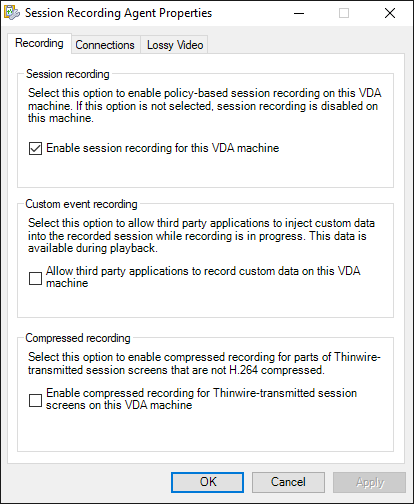
Note:
- This feature is disabled by default.
- The minimum version required for the VDA is 2303.
For more information, see Enable or disable recording.
Image resolution scaling for lossy video codec
The lossy video codec lets you adjust compression options to reduce the size of recording files and to accelerate navigation through recorded sessions during playback. This release adds a compression option, image resolution scaling, to the lossy video codec feature. Image resolution scaling lets you downscale the resolution of recorded screens.

For more information, see Enable or disable lossy video codec.
Enhanced notification for event response actions
Starting with Session Recording 2206, you can disconnect, log off, or lock users from their virtual sessions when a specific event is detected. You can also notify users of the actions by setting the time interval between a notice and its execution. This release enhances the notification feature by giving users a clearer understanding of the reason behind the actions. For an example notice, see the following screen capture:
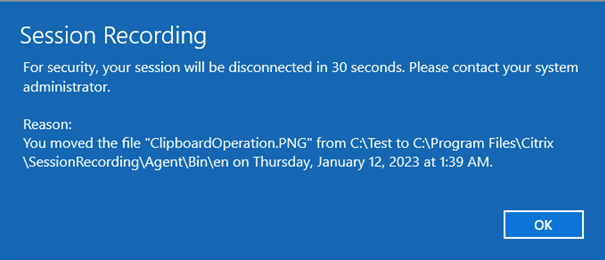
For more information, see Create a custom event response policy.
Google Analytics disabled for EU customers by default
Google Analytics is now disabled for EU customers by default. For more information, see CEIP and Google Analytics.
More optional parameters for ICLDB commands
This release introduces the RELOCATE parameter to the IMPORT command and the FILTER parameter to the ARCHIVE and REMOVE commands of the ICLDB utility.
-
The RELOCATE parameter for ICLDB IMPORT
You can move session recording files to different storage paths for the load balancing or other purposes. To ensure that the files can still be played, you must update their new paths to the Session Recording database. To do so, use the ICLDB IMPORT command. To accelerate the import process, append the RELOCATE parameter to the ICLDB IMPORT command.
Without the RELOCATE parameter, the ICLDB IMPORT command parses session recording files in their entirety, which takes time. With the RELOCATE parameter, the ICLDB IMPORT command simply locates the database records of session recording files and updates their file paths directly.
-
The FILTER parameter for ICLDB ARCHIVE and ICLDB REMOVE
Previously, only the RETENTION parameter was available for the ICLDB ARCHIVE and ICLDB REMOVE commands to specify target session recording files to manipulate. Starting with this release, you can add the FILTER parameter to manipulate session recording files that meet both RETENTION and FILTER. The FILTER parameter lets you filter file paths by using the
*and?wildcards.
For more information about the ICLDB utility, see Manage recordings.
What’s new in 2212
This release includes the following new features and addresses issues to improve the user experience:
Lossy video codec
The lossy video codec lets you adjust compression options to reduce the size of recording files and to accelerate navigating recorded sessions during playback. It is suitable for use when:
- the size of recording files per time unit is too large, or
- there is a lag while you fast forward or rewind during playback.
For more information, see Enable or disable lossy video codec.
Playback justification logging
This release introduces playback justification logging and creates a Playback Logging page to aggregate all playback logs. With playback justification logging enabled, each time a user plays a recording, a dialog box appears, asking the user to enter a justification for playback. For more information, see Playback logging.
What’s new in 2210
This release includes the following new features and addresses an issue to improve the user experience:
Support for installation in session 0
This release introduces the AllowSession0Install argument for you to automate the installation of the Session Recording administration components in session 0. For more information, see Automate installation.
What’s new in 2209
This release includes the following new features and addresses an issue to improve the user experience:
Recording access control
You can now place access restrictions on target recordings in addition to role-based access control through recording viewing policies. Restricted recordings are accessible only to users and user groups that are assigned the PrivilegedPlayer role through the Session Recording Authorization Console. For more information, see Place access restrictions on recordings in the web player and Place access restrictions on recordings in the Session Recording player.
What’s new in 2207
This release includes the following new features and addresses an issue to improve the user experience:
Improved performance of the web player
We have optimized the graphics engine to improve the performance of the web player. If you encounter compatibility or other issues with the optimized engine, you can disable it through the Configuration > Preferences menu on the web player page. For more information, see Configure preferences.
What’s new in 2206
This release includes the following new features and enhancements:
Regular session recording storage reports
You can now schedule reports through Session Recording Server Properties to receive emailed session recording storage reports on a daily or weekly basis. A session recording storage report provides weekly statistics on screen recordings. For more information, see Session recording storage reports.
Support for additional event response actions
In addition to email alerts and dynamic screen recording, you can now specify the following actions in response to logged events in recorded sessions:
- Lock session
- Log off session
- Disconnect session
For more information, see Configure event response policies.
What’s new in 2204
This release addresses issues to improve the user experience.
What’s new in 2203 LTSR (initial release)
This release includes the following new features and enhancements:
Monitoring popup window events
When users open or close a confidential file or access a folder, a popup window might appear, showing a prompt or asking for a password. Session Recording can now monitor such popup window events while recording sessions. Popup windows in web browsers are not monitored. For more information, see Configure event detection policies.
Responses configurable for more event types
You can now specify how to respond when the following session events are detected:
- File transfers between session hosts (VDAs) and client devices
- Windows registry modifications
- User account modifications
- App failures
- App installs and uninstalls
- RDP connections
- Clipboard activities
- Popup window events
- Performance data (data points related to the recorded session)
For more information, see Configure event response policies.
Configurable time span for screen recording before a session event is detected
When you specify events to trigger dynamic screen recording, you can configure the amount of time of the screen recording you want to keep before events are detected. The actual length of the screen recording that Session Recording keeps might be a little longer than your configuration.
This feature is available only for virtual desktop sessions. For more information, see Configure event response policies.
What’s new in 2201
This release addresses issues to improve the user experience.
What’s new in 2112
This release includes the following new features and addresses an issue to improve the user experience:
Integration with Citrix Analytics for Security™
You can now configure Session Recording servers to send user events to Citrix Analytics for Security, which processes those user events to provide actionable insights into user behaviors.
For more information, see Integrate with Citrix Analytics for Security.
Extended scope of event detection
We have extended the scope of event detection to monitor the following events while recording sessions:
- App failures: including unexpected app exits and unresponsive apps.
- User account modifications: including account creation, enablement, disablement, deletion, name changes, and password modification attempts.
- RDP connections: RDP connections initiated from the VDA hosting the recorded session.
- App installs and uninstalls
For more information, see Create a custom event detection policy.
Session data overlay
This release introduces a screen overlay during session playback in the web player. It is a semi-transparent overlay that you can relocate and hide. The overlay features the following data points related to the recorded session:
- Round trip time
- Network (send)
- Network (receive)
- CPU usage
- Memory usage
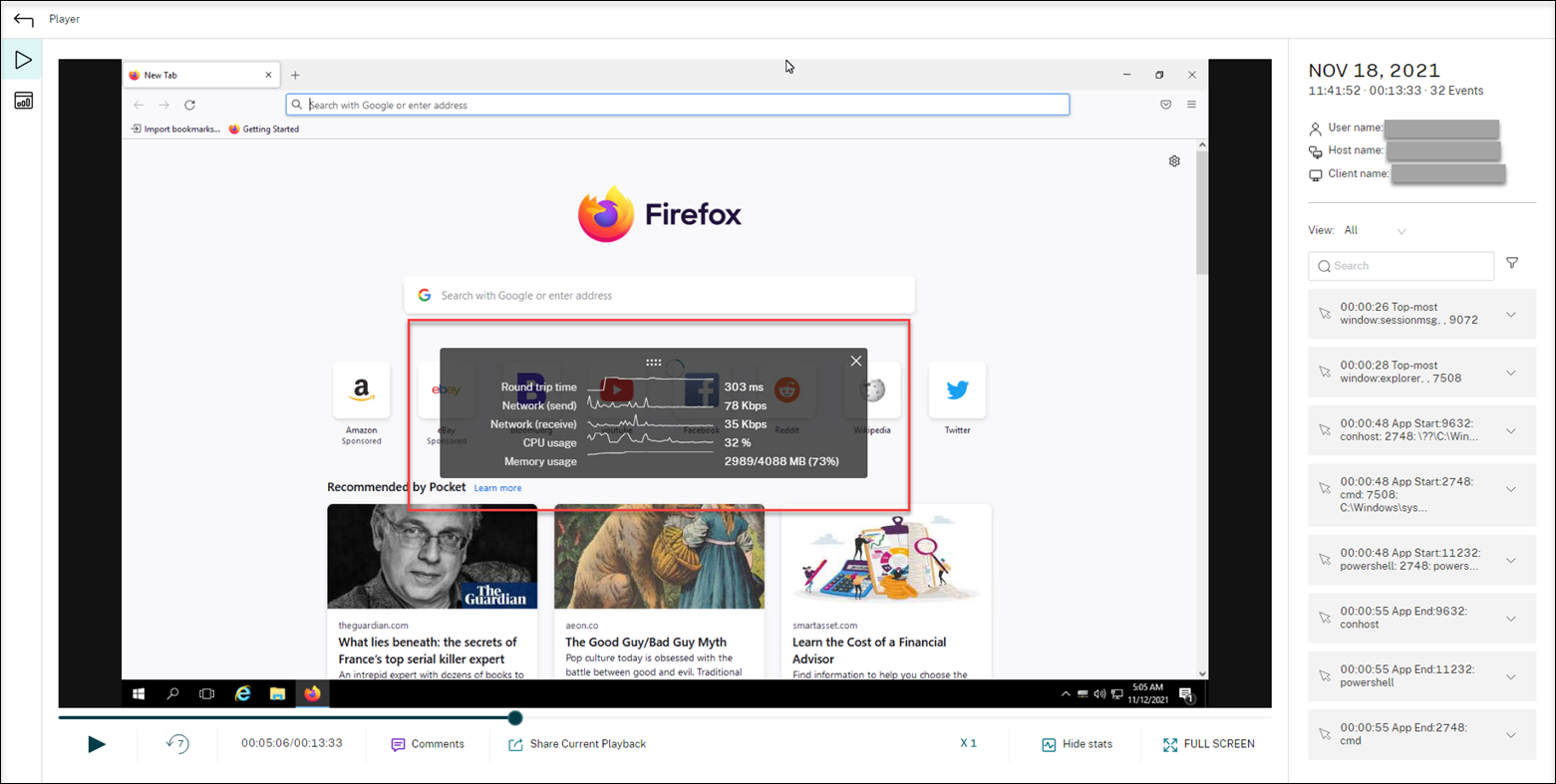
To enable the feature, select Log performance data when creating your event detection policy. For more information, see Create a custom event detection policy and Session Recording web player.

What’s new in 2110
This release addresses issues to improve the user experience.
Note:
Starting with 2110, before installing the Session Recording Administration components on Windows Server 2016 where TLS 1.0 is disabled, complete the following steps:
- Install Microsoft OLE DB Driver for SQL Server.
Under the
HKEY_LOCAL_MACHINE\SOFTWARE\Microsoft\.NETFramework\v4.0.30319registry key, add theSchUseStrongCryptoDWORD (32-bit) value and set the value data to 1.- Reboot.
What’s new in 2109
The 2109 release includes the following new features and addresses issues to improve the user experience:
Windows 11 support
The Citrix components, features, and technologies in this release that support the Windows 10 OS now also support Windows 11, unless otherwise noted. For more information, see Windows 11 support.
Support for event data visualization
Event data visualization is now available in the web player for each recording. It provides graphical event statistics that help you quickly comprehend large numbers of events inserted in recordings, allowing you to easily see and communicate event trends. For more information, see View graphical event statistics in the Session Recording web player article.
Monitor registry modifications
We have extended the scope of event detection to monitor the following registry modifications while recording sessions:
| Registry modification | Corresponding event |
|---|---|
| Adding a key | Registry Create |
| Adding a value | Registry Set Value |
| Renaming a key | Registry Rename |
| Renaming a value | Registry Delete Value and Registry Set Value |
| Changing an existing value | Registry Set Value |
| Deleting a key | Registry Delete |
| Deleting a value | Registry Delete Value |
For example:

To enable this registry monitoring functionality, select the Log registry modifications option for your event detection policy. For more information, see Create a custom event detection policy and Log events.
Renamed policies
In the Session Recording Policy Console, we have renamed the following recording policies and options for event detection settings:
| Old name | New name |
|---|---|
| Record event only for everyone with notification | Record only events (for everyone, with notification) |
| Record event only for everyone without notification | Record only events (for everyone, without notification) |
| Record everyone with notification | Record entire sessions (for everyone, with notification) |
| Record everyone without notification | Record entire sessions (for everyone, without notification) |
| Log sensitive file events | Log file operations |
| Log top-most window activities | Log topmost window events |
Renamed recording policies:
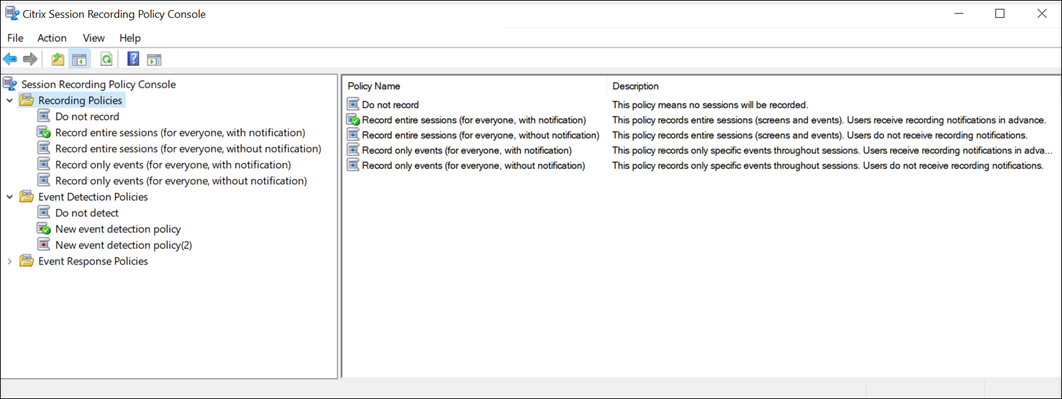
Renamed options for event detection settings:
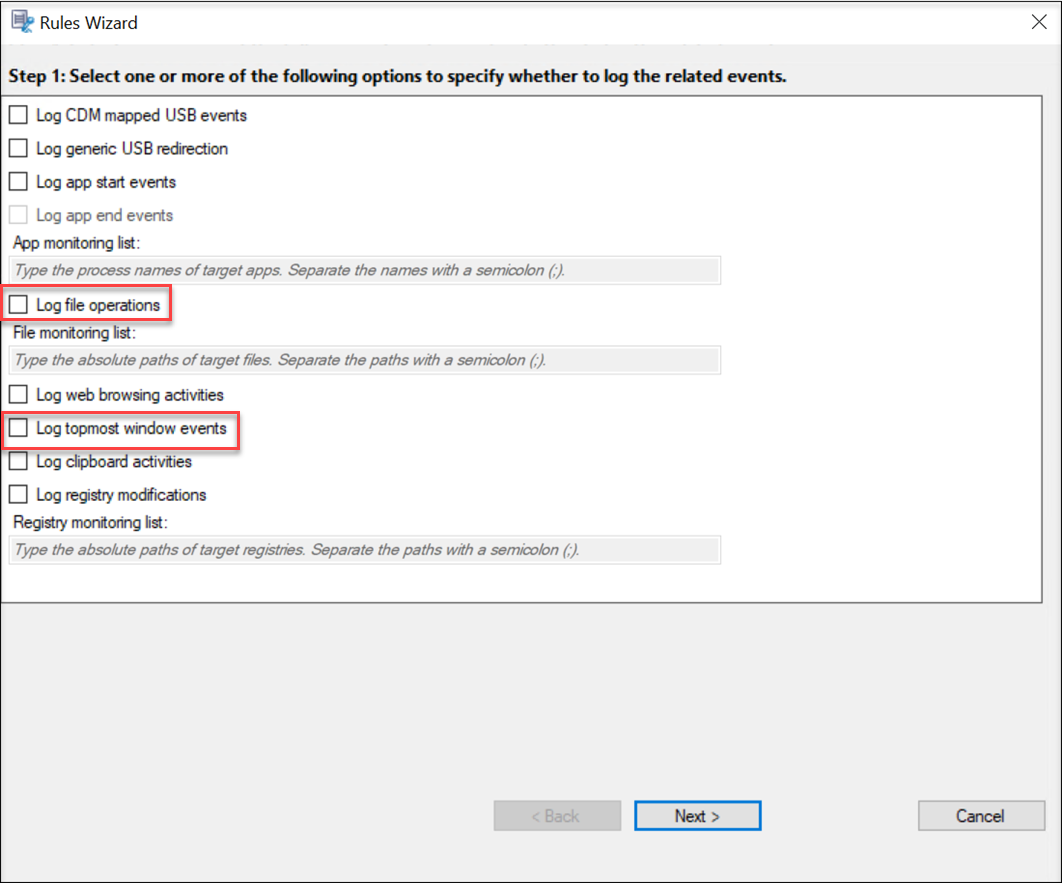
What’s new in 2107
This release includes the following new features and addresses issues to improve the user experience:
Event-triggered dynamic screen recording
The 2106 release introduced event-only recordings - the ability to record only specific events throughout a session - without capturing any screens. However, there are scenarios where you might want to automatically start recording screens when certain events occur during an event-only recording. As of this release, you can configure this recording behavior (event-triggered dynamic screen recording) using event response policies. For more information, see Event response policies.

Tip:
In this release, we renamed Email Alert Policies to Event Response Policies and Event Logging Policies to Event Detection Policies.
What’s new in 2106
This release includes the following new features and enhancements:
Windows Server 2022 support
Components, features, and technologies that support Windows Server operating systems now also support Windows Server 2022, unless noted otherwise. For more information, see Windows Server 2022 support.
Monitor file transfers
We’ve extended the scope of event logging to monitor file transfers between session hosts (VDAs) and client devices (including mapped client drives and generic redirected mass storage devices). Selecting the Log sensitive file events option for an event logging policy triggers the logging of file transfers, no matter whether you specify the File monitoring list. This enhanced feature requires Windows VDA 2106 or later. For more information, see Configure policies.
Record events only
In addition to recording screens, you can now record only specific events. This feature helps to free up storage space. To use this feature, activate either of the following new system-defined policies and then set an event logging policy to specify which events to record.
- Record event only for everyone with notification
- Record event only for everyone without notification
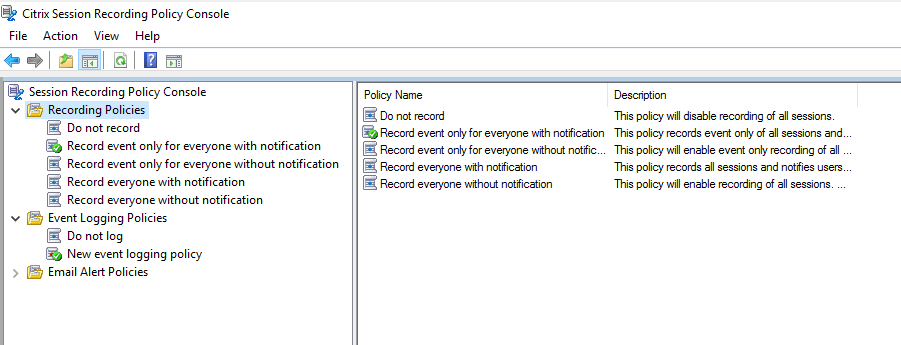
An event-only recording played in the web player contains an event statistics pie chart and histogram. The pie chart and histogram hold static throughout playback. You can navigate to a specific event from within the right pane.
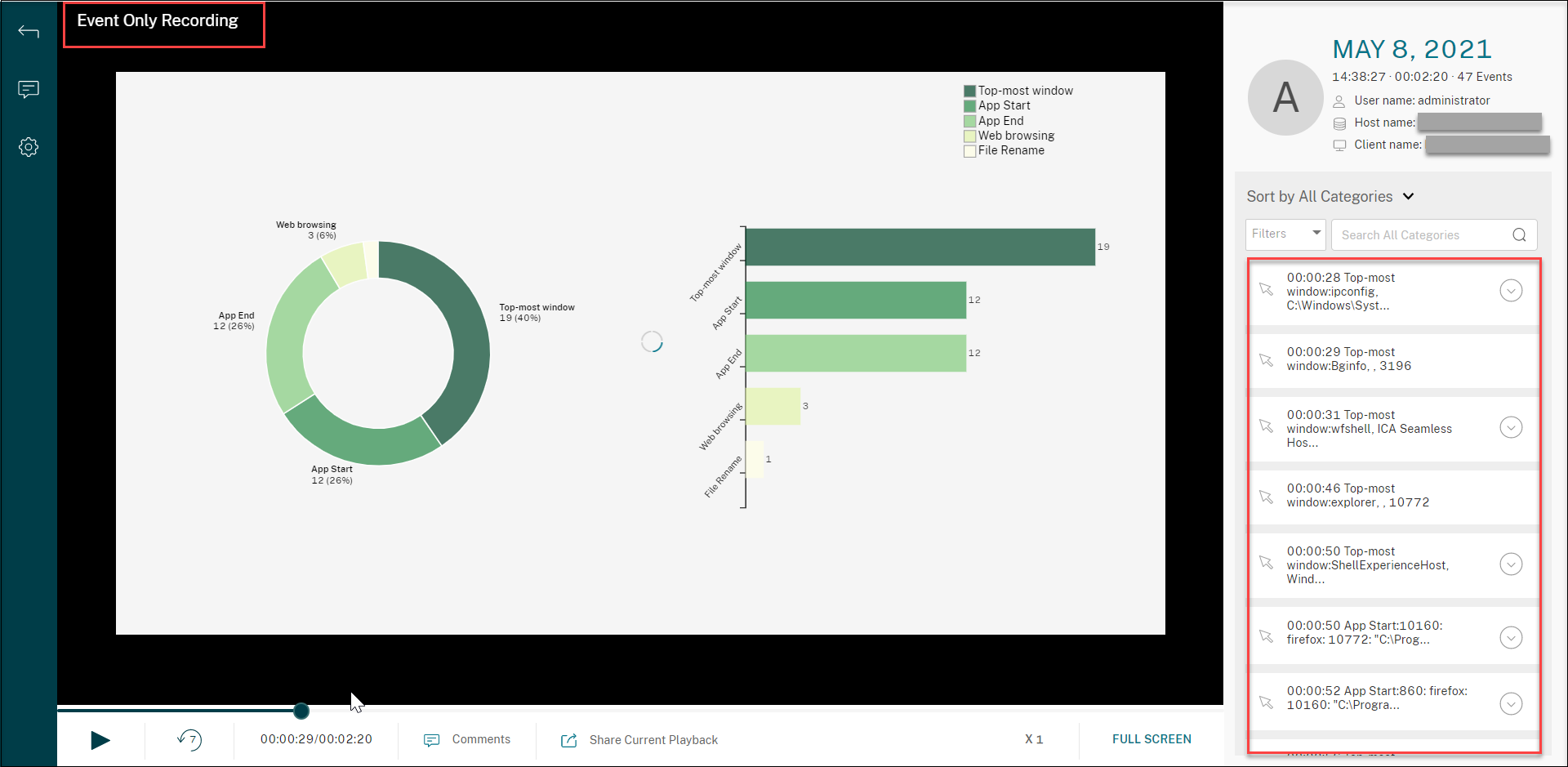
The following screen capture shows an example of an event-only recording being played in the Session Recording Player. The EventOnly column indicates a screen recording or an event-only recording. All events are present in the Events and Bookmarks panel and show as yellow dots in the lower part of the Session Recording Player.
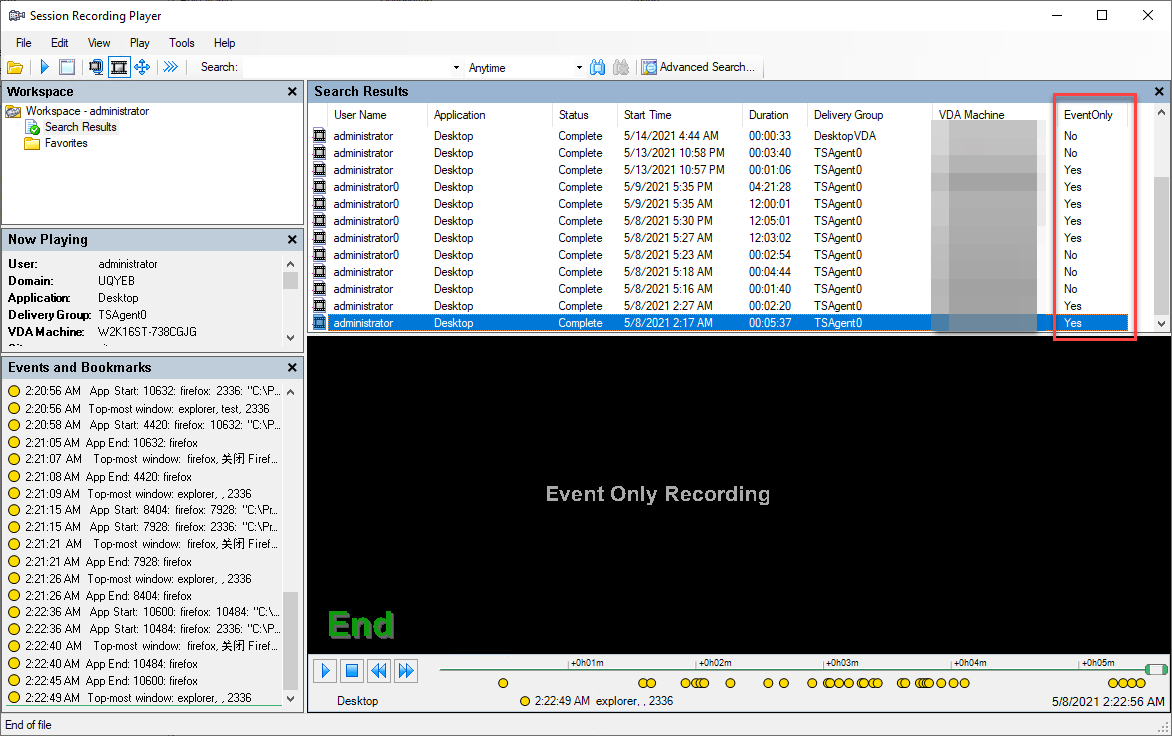
For more information, see Configure policies.
What’s new in 2104
This release includes the following enhancements and addresses an issue to improve the user experience:
Enhancement to recording file creation and storage
Previously, recording files were created and visible in the recording storage folder for all sessions when they were launched. The files were then deleted if policies were set not to record the launched sessions. As of this release, recording files are created only for recorded sessions.
What’s new in 2103
This release includes the following new features and enhancements:
Support for deploying the Database on AWS RDS
You can now deploy the Session Recording Database on AWS RDS by using the SessionRecordingAdministrationx64.msi package under \layout\image-full\x64\Session Recording on the Citrix Virtual Apps and Desktops ISO. For more information, see Deploy the Session Recording Database on cloud SQL database services.
Support for Azure Files and load balancing in Azure
You can now store recording files in Azure file shares that you can mount to both cloud and on-premises deployments. You can also deploy all Session Recording components in Azure and configure load balancing to evenly distribute loads across Session Recording Servers. For more information, see Specify where recordings are stored and Deploy and load-balance Session Recording in Azure.
Citrix Virtual Apps and Desktops™ Remote PowerShell SDK support for dynamic session recording
We have added support for the Citrix Virtual Apps and Desktops Remote PowerShell SDK to facilitate dynamic session recording in a Citrix Virtual Apps and Desktops service environment. For more information, see Dynamic session recording.
Font and color redesigns for the web player website
We have implemented font and color redesigns on the web player website. For more information, see Session Recording web player.
Recording playback enhancements
As recordings grow in size, recording files can take longer to download and respond more slowly when you use the seek slider to navigate during playback. To enhance playback, we’ve decreased the recording file limit from 1 GB to 300 MB and ensured continuous playback by splitting a single recording into multiple files. You can also right-click or select a recording and then choose or click Follow up to show all recording files of the recorded session. For more information, see Specify file size for recordings, Launch the Session Recording Player, and Session Recording web player.
Hiding content on the web player home page
We have added an option in Session Recording Server Properties. It lets you prevent the web player home page from displaying any content. Recordings are accessible only by way of their URLs. For more information, see Session Recording web player.
Migrating the WebSocket server to IIS
This release migrates the WebSocket server to IIS. A fresh installation of the latest Current Release connects your web browser to the WebSocket server hosted in IIS when you access the web player website. An upgrade installation from an earlier version to the latest Current Release connects your web browser to the original Python-based WebSocket server. To connect to the WebSocket server hosted in IIS, run the <Session Recording Server installation path>\Bin\SsRecUtils.exe -enablestreamingservice command. For more information, see Session Recording web player and Configure load balancing in an existing deployment.
Tip:
Starting from this release, the
ArchiveSample.ps1,SrServerConfigurationSync.ps1, andGenRandomQMID.ps1scripts are available under <Session Recording Server installation path>\Scripts\.
In this article
- What’s new in 2503
- What’s new in 2411
-
What’s new in 2407
- Hide screen areas for specific applications during Thinwire screen recording
- Capture printing activities in recorded sessions (preview)
- Report message queue quota exceedance on each VDA to the Session Recording server
- Dynamic screen recording through Citrix PowerShell SDKs extended to event-only recording
- What’s new in 2402 LTSR (initial release)
-
What’s new in 2311
- Audio recording for non-optimized HDX™ audio is now generally available
- Prerecording also available for virtual app sessions
- Hide specific applications during screen recording
- Explicit user consent before recording sessions
- Store recording files in Amazon Simple Storage Service (Amazon S3)
- Ability to play completed and live session recordings on Citrix Director
- Regular event response reports
- Ability to check the recording success rate
-
What’s new in 2308
- Audio recording for non-optimized HDX audio (preview)
- Fast seeking through ICA® screen recording
- Lossy video codec renamed to lossy screen recording
- Support for installing the Session Recording database on the Google Cloud SQL Server
- Ability to close unresponsive or dormant live recordings
- More parameters are available for ICLDB ARCHIVE, ICLDB REMOVE, and ICLDB DORMANT commands
- What’s new in 2305
- What’s new in 2303
- What’s new in 2212
- What’s new in 2210
- What’s new in 2209
- What’s new in 2207
- What’s new in 2206
- What’s new in 2204
- What’s new in 2203 LTSR (initial release)
- What’s new in 2201
- What’s new in 2112
- What’s new in 2110
- What’s new in 2109
- Renamed policies
- What’s new in 2107
- What’s new in 2106
- What’s new in 2104
-
What’s new in 2103
- Support for deploying the Database on AWS RDS
- Support for Azure Files and load balancing in Azure
- Citrix Virtual Apps and Desktops™ Remote PowerShell SDK support for dynamic session recording
- Font and color redesigns for the web player website
- Recording playback enhancements
- Hiding content on the web player home page
- Migrating the WebSocket server to IIS